|
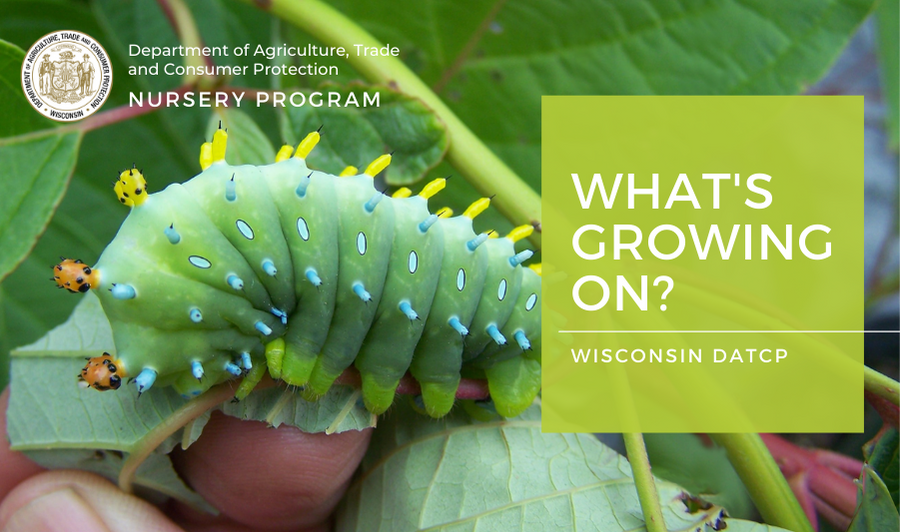 _____________________________________
Dear Wisconsin nurseries, Christmas tree growers, and gardeners:
Growing degree days (GDD)(simple B50) as of August 14 were 1160 in Bayfield, 1506 in Cumberland, 1390 in Medford, 1682 in Hancock, 1850 in Green Bay, 2040 in Racine, 2023 in Madison, 1980 in La Crosse, and 2267 in Dubuque, IA. A few pests in vulnerable-to-treatment stages include flat-headed and round-headed apple tree borer and pine needle scale at 1600-1700, locust borer and fall webworm at 1800-2100 GDDs and final applications for two-spotted spider mite at 2100-2200 GDDs. Apply second applications for Viburnum crown borer, and Zimmerman pine moth at 2700-2900 GDDs. Other pests soon to be in vulnerable stages for fall applications include cooley and eastern spruce gall adelgid at 2800-3000 GDDs, spruce spider mites and woolly apple aphids at 2900-3100 GDDs and spruce needle miner at 3000-3200 GDDs.
Please send any feedback, questions, or ideas for future e-news updates to datcpnursery@wisconsin.gov.
Having trouble viewing this email? View it as a Web page.
_____________________________________
|
|
|
Elm Zigzag Sawfly feeding damage and lacy spent pupal case | DATCP G. Meysembourg
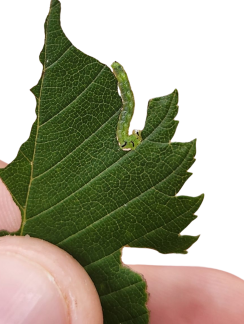
DATCP made an unexpected discovery last month when staff found all life stages of the invasive elm zigzag sawfly (Aproceros leucopoda) (EZS) in Portage County, including green caterpillar-like larvae with dark bands on their heads and legs, sticky green pupae, and black adult sawflies with light yellow legs. (image left of initial find. Photo credit: DATCP M. Lannan) A state record for the first detection of this species in Wisconsin was confirmed by USDA-APHIS on July 30, 2024. Since first sighted, this pest has been observed in Adams, Brown, Dane, Jackson, Kenosha, La Crosse, Marquette, Milwaukee, Ozaukee, Pierce, Portage, Rock, Sauk, Sheboygan, St. Croix, Washington, Waukesha, Waupaca and Winnebago counties. EZS was also confirmed in Minnesota for the first time this month as well.
Native to east Asia, this pest was first discovered in North America in Canada in 2020 and has since spread to several eastern and Midwest states in the US. Multiple yearly generations of flight-capable, asexually reproducing adults allow this pest to spread rapidly, in combination with human-assisted movement via hitchhiking on vehicles, plants, and other outdoor items.
Elm zigzag sawfly can feed on the leaves of any elm species, leaving a distinctive zigzag pattern. Severe defoliation may occur and cause branch dieback, but direct tree mortality is unlikely. While most healthy trees can recover from defoliation stress, many elms are already experiencing decline due to Dutch Elm Disease, among other pests and diseases. The full potential impact of this pest on Wisconsin’s wildland and urban forest ecosystems is therefore currently unknown.
There are no current or planned federal or state quarantines for EZS. Licensed nurseries that suspect they may have this pest should contact their local inspector or email DATCPnursery@wisconsin.gov for diagnostic support and management recommendations. Nursery stock infested with EZS does need to be treated prior to sale and shipment to avoid long-distance pest spread via commerce. See the UW-Madison Extension website for more information about this pest and its management.
|
_____________________________________
|
|
|
August is Tree Check Month, which means it is time to check your trees for signs of invasive pests. An emerging invasive pest to be on the lookout for is the spotted lanternfly (Lycorma delicatula) (SLF), a type of planthopper native to parts of Asia. SLF was first found in Pennsylvania in 2014 and has since spread to at least 17 states, including Illinois and Michigan. SLF weakens plants by sucking large volumes of sap from trees and vines. Some of its favorite plants to feed on include tree-of-heaven, grapevines, hops, apple, roses, maple, walnut, willow, and poplar. All life stages of SLF are avid hitchhikers and are often moved long distances and into new areas on firewood, nursery stock, rail cars, vehicles, shipping containers, bricks, stone, and other materials moved by humans.
SLF lays eggs in fall on host plants as well as on a variety of surfaces/objects found outside. The egg masses are one to two inches long and look waxy and gray at first, then become hardened and cracked as the season goes on. The eggs hatch in late spring and early summer, and after this, individual eggs are noticeable, looking like four to seven rows of dark brown “seeds.” Once hatched, the wingless black nymphs (juveniles) with white spots begin feeding. They start developing into later stage nymphs with the addition of red coloring to their black bodies with white spots. Adults develop after late July and continue feeding until November – not necessarily on the same host plant as the nymphs. Adults have brown or pinkish-purple wings with black spots when folded. When outspread, the upper wings are white to tan, and the lower wings have distinctive red, black, and white markings. The tips of both sets of wings are dark brown to black. Adults are 1 inch long and 1½ inch wide when wings are outspread.
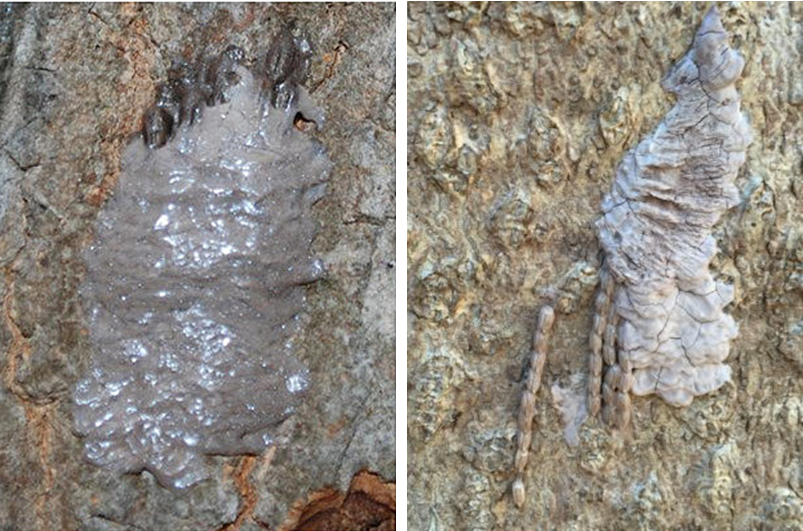 |
Newly laid SLF egg mass (left) and older egg mass showing individual egg rows (right) | NJ Department of Agriculture and Penn State Extension
SLF nymphs (top left) and adults (top right and bottom) | USDA-ARS S. Ausmus, PA Dept. of Agriculture L. Barringer
Early detection is the best strategy for keeping spotted lanternfly out of Wisconsin. Always inspect your vehicles, trailers, or any outdoor items when traveling from an area where spotted lanternfly is known to occur. We also encourage you to inspect plant material for SLF nymphs or adults during the growing season, especially on tree-of-heaven and grapevines, and to check for egg masses throughout winter. Given that tree-of-heaven is an invasive species itself, removing it can proactively protect your community from SLF while also improving local habitats.
To learn more about SLF, check out slf.wi.gov or USDA APHIS SLF webpage.
If you think you found any life stage of SLF, note the precise location, take clear pictures, and report it! You can also collect individuals in a container and freeze them, which helps preserve the insect for later identification by state or federal officials.
Report SLF found in Wisconsin by calling DATCP at (866) 440-7523 or using the following link: Report a Sighting of Spotted Lanternfly in Wisconsin (arcgis.com).
_____________________________________
|
|
|
The Winsome Fly, Istocheta aldrichi (Mesnil), in the Tachinidae family, is a parasitoid of Japanese beetle (JB), Popillia japonica. The Winsome fly (WF) was introduced as a biological control agent of JB in 1923 in New Jersey, just six years after the accidental introduction of the beetle in the U.S. Since then, WF became well established in the northeastern states, as well as Quebec and Ontario, Canada. It’s also notable, about 18 years since it was introduced in Minnesota, that WF expanded its range from eight counties, as of 2023, to 22 counties this summer.
Since 2021, WF has now been documented in eight counties in Wisconsin. The furthest east detection this year was south of Wausau (Marathon Co.) WF is considered one of the more effective biological control agents of JB due to its current phenological match between adult fly emergence and that of JB emergence, the direct impact of 20-60% parasitism rates, major reductions in female fecundity that results in population suppression the following year, and its ability to adapt to a variety of climatic conditions.
The easiest way to detect activity of WF is not the adult fly itself (these are very difficult to see in the field and properly identify), but its best to search for the distinctive white eggs laid just behind the head (pronotum) of the Japanese beetle.
Winsome Fly eggs are easy to see in the field. WF eggs on 3 Japanese beetles, including a mating pair (Female JB below the male). One or more eggs are laid on each beetle; eggs are nearly always laid just behind the head (pronotum). WF prefers to lay its eggs on female JB. In most cases, only one egg is deposited per beetle. | Image Credit: Jacques Lasnier, Quebec
Request! Given the recent detections in Wisconsin, and with a climate similar to that of Minnesota, we anticipate that WF is in many more counties. Although the JB season, and that of WF, are winding down, it would be great if more observers could look for this important biocontrol agents in Wisconsin! Please refer to the following pages for more information, including how to post observations on iNaturalist, at: https://tips.umn.edu/current/winsom-fly-survey You can also view links to detailed instructions to participate here: https://blog-fruit-vegetable-ipm.extension.umn.edu/2024/07/consider-joining-winsome-fly-survey.html.
All questions about the project should be emailed to: winfly2024@umn.edu.
--Contributing Author Bill Hutchison, Dept. of Entomology & UMN Extension, University of Minnesota
_____________________________________
|
|
 Field of fir Christmas trees in Jackson County | DATCP image
Christmas tree field inspections will begin in September. Prior to inspection season, Christmas tree growers can familiarize themselves with the regulatory requirements regarding spongy moth for trees being shipped out of the spongy moth quarantine and elongate hemlock scale (EHS) for cut trees, wreaths, and roping being shipped into Wisconsin.
Spongy moth populations were relatively high last year, with egg masses found in or around 49 Christmas tree fields in 2023. When spongy moth egg masses are found, the impacted field are subject to shipping restrictions. Growers receive a restriction letter prior to harvest, detailing the specific restrictions (based on the number of egg masses and proximity to Christmas trees). Growers that had spongy moth egg mass finds last fall and received a treatment letter this spring should have returned the treatment record to DATCP. If you received a treatment letter but have not yet returned the treatment record, please send it to DATCP as soon as possible, even if you do not plan on shipping out of quarantine and did not apply a pesticide treatment. If you have questions regarding spongy moth regulations, contact Brooke Sanneh, Christmas Tree Program Coordinator, at (608) 235-7861 or Brooke.Sanneh@wisconsin.gov.
Christmas tree growers who import Christmas trees, wreaths, or cut material from EHS infested states need a DATCP compliance agreement prior to receiving these shipments. If the receiving grower does not have a DATCP compliance agreement, a certificate such as a state phytosanitary certificate or a certificate of quarantine compliance issued by state officials from the exporting state must be included in each shipment into Wisconsin.
If you have any questions regarding EHS regulations or need to obtain a compliance agreement with DATCP, contact Meg Sanders, Forest Pest Regulatory Coordinator, at (715) 891-8158 or meganT.Sanders@wisconsin.gov.
_____________________________________
|
|
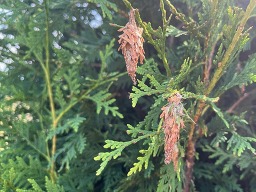 Bagworm larvae on arborvitae in Kenosha Co. | DATCP M. Wensing
|
 Foliar nematodes and virus on 'Mustang Sally' hosta in Juneau Co. | DATCP L. Meils
|
|
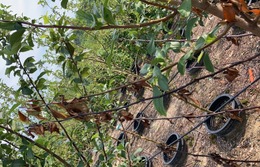 Fireblight on crabapple in Jackson Co. | DATCP M. Sanders
|
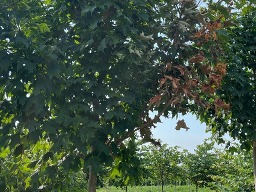 Verticillium wilt on maple in Rock and Kenosha counties | DATCP M. Wensing
|
|
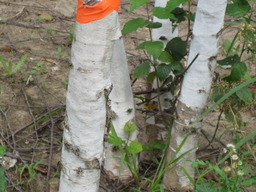 Bronze birch borer tunneling on birch in St. Croix Co. | DATCP image
|
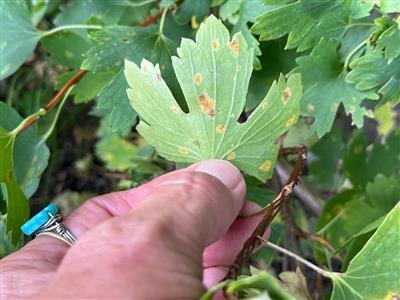 Rust on ribes (alternate host for white pine blister rust) in Racine Co. | DATCP M. Wensing
|
|
|
_____________________________________
|
|
|
|
|